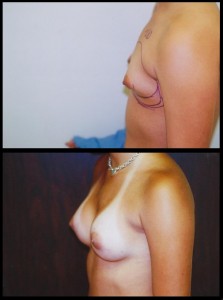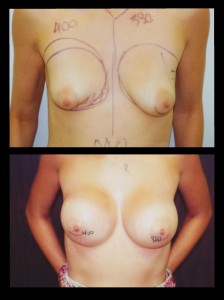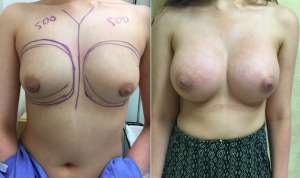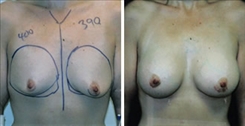Tubular Breast Deformity Beverly Hills
Posted On: November 30, 2018 Author: The Office of Dr. Stuart Linder Posted In: Tubular Breast
Patients who present with tubular breast deformity are often very unhappy, not just with the size of their breasts, but actually with the shape. The components of tubular breast deformity include No. 1, a poorly defined inframammary fold. In other words, there is no fold along the bottom of the breast or it is not defined well. No. 2, a flattening or blunting of the lower pole of the breast in which there is no round shape to the lower breast causing a conical or tubular shape, almost a triangular shape, on an oblique or side view. Finally, there is also a pseudo-herniation of breast tissue into the nipple-areolar complex. This means that the glandular thick or fatty tissue actually pushes the nipple-areolar complex out performing a protrusion that does not look pleasing to the patients.
It is highly recommended that these patients undergo augmentation mammoplasty procedure either through saline or silicone implants under the muscle with the dual plane technique if it’s a minimal tubular breast. If it’s an endomorphic thick barrel chest, then we often place the implants above the muscle, subglandular, or retromammary plane. We also release along the inframammary fold in a radial striated fashion in order to round out the lower pole of the breast. We see patients with tubular breast deformity each and every week, if not several a week, who are really distraught and frustrated with not only the size of the breast, again with a conical tubular shape of the breast, which can be corrected.
Now, post-surgically, it is very important that patients maintain a sports bra or athletic bra for approximately six weeks. They can be fitted into the new Dr. LinderBra™, which allows for support, but will not allow the inframammary fold to end up too high. We also have an upper pole compression band that pushes down on the implants and the muscle and it relaxes the implant and displaces it inferiorly so that 1) it allows rounding out of the lower portion of the breast pocket; and 2) it does not allow the implants to settle into a too superior position. In other words, the implants don’t end up too high. So, it is apparent that tubular breast deformities are significant in the population and at least two to three percent of my patients for breast augmentation will present with this. We can correct this in a useful manner that is predictable as long as the implants are placed correctly, the fold is released, there is release along the lower pole of the breast fascia and a band is used for a significant period of time in order to maintain the lowering of the position of the implants.
Case Study #1
TUBULAR BREAST DEFORMITY RECONSTRUCTION SURGERY
 The following patient is 18 years of age, who presented with her mother for severe tubular breast deformity. Components include decreased distance from the inferior areolar of the inframammary fold, hypoplastic lower breast, poorly defined inframammary fold, and obvious herniation of breast tissue into the nipple-areolar complex. She is an excellent candidate for a breast augmentation procedure using high profile implants in the dual plane technique. She wanted a very natural and simple result and therefore we took her from a 32A to a small C. A 280 cc high profile implant was filled to 315 cc. Using the dual plane technique, radial striation of the lower portion of the breast was accomplished of the pectoral major fascia and lower breast tissue in order to round out the breast. On both frontal and oblique views, it shows that the implant has been positioned precisely with good symmetry, good cleavage, and symmetry of the inframammary fold.
The following patient is 18 years of age, who presented with her mother for severe tubular breast deformity. Components include decreased distance from the inferior areolar of the inframammary fold, hypoplastic lower breast, poorly defined inframammary fold, and obvious herniation of breast tissue into the nipple-areolar complex. She is an excellent candidate for a breast augmentation procedure using high profile implants in the dual plane technique. She wanted a very natural and simple result and therefore we took her from a 32A to a small C. A 280 cc high profile implant was filled to 315 cc. Using the dual plane technique, radial striation of the lower portion of the breast was accomplished of the pectoral major fascia and lower breast tissue in order to round out the breast. On both frontal and oblique views, it shows that the implant has been positioned precisely with good symmetry, good cleavage, and symmetry of the inframammary fold.
Tubular breast reconstruction requires an approach that is safe and predictable. I believe the periareolar approach is easy in order to maintain the inframammary fold and release the lower pole of the breast in order to round out the breast, which is something lacking in tubular breast patients.
Case Study #2
BREAST ASYMMETRY + TUBULAR BREAST CORRECTION
 A young lady presented with severe tubular breast deformity with grade 2 ptosis of the left breast and severe breast asymmetry. The patient declined to have any scarring with breast lifts performed. In any case, the patient underwent augmentation mammoplasty with saline high profile smooth implants, 330 cc filled to 400 on the right, 330 cc filled to 380 cc on the left using the dual plane technique, periareolar approach and radial striation of the lower pole on the right breast. Her before and after photographs are shown for reference.
A young lady presented with severe tubular breast deformity with grade 2 ptosis of the left breast and severe breast asymmetry. The patient declined to have any scarring with breast lifts performed. In any case, the patient underwent augmentation mammoplasty with saline high profile smooth implants, 330 cc filled to 400 on the right, 330 cc filled to 380 cc on the left using the dual plane technique, periareolar approach and radial striation of the lower pole on the right breast. Her before and after photographs are shown for reference.
Interestingly, the left breast pocket was made very conservative, especially lateral to the areolar border, which allowed the implant to sufficiently tighten up the left breast skin without the necessity of a breast lift. Her cleavage is actually quite good as well. The most important part of this operation was releasing the right breast lower pole inferiorly in order to reduce the tubular shape of the breast (this can be seen nicely on the oblique view), also limiting the pocket dissection on the side of the breast and using high profile saline implants in the dual plane technique, two-thirds under and one-third over. This is an interesting case. Once again, the successful surgery on a patient presenting with tubular breast deformity, sagginess or grade 2 ptosis of the left breast and asymmetry without the use of breast lift scarring.
Case Study #3
MILD TUBULAR BREAST DEFORMITY
 The patient to the right presented with a mild tubular breast deformity. Her preoperative photo shows a conical appearance to the breast and a poorly defined inframammary fold along the bottom of the breast. During her consultation, she expressed that she wanted to achieve more rounded breasts with fullness. After setting her expectations, we agreed to schedule an augmentation mammoplasty procedure using 500 cc high profile saline breast implants.
The patient to the right presented with a mild tubular breast deformity. Her preoperative photo shows a conical appearance to the breast and a poorly defined inframammary fold along the bottom of the breast. During her consultation, she expressed that she wanted to achieve more rounded breasts with fullness. After setting her expectations, we agreed to schedule an augmentation mammoplasty procedure using 500 cc high profile saline breast implants.
The 27-year-old patient is now six weeks post-op. As you can see by the photo, she has nice fullness and a rounded appearance.
Case Study #4
Tubular Breast Deformity, Severe
The patient presents with severe tubular breast deformity. Her preoperative photographs show conical appearance to the breast, poorly defined inframammary folds, flattening to the bottom of her breast (left greater than right), and pseudo-herniation of the nipple areolar complex. The patient is an exceptionally good candidate for tubular breast augmentation/reconstruction with high profile saline implants placed in the dual plane technique with radial striation of the lower poles of her breast.
 I placed markings with 390 cc of high profile saline on the right and 400 cc on the left to regain symmetry. She had partial resection of the retroareolar tissue with dual plane augmentation mammoplasty procedure as well as formal radial striation of the breast without any form of breast lift. Her postoperative photograph shows a one-year postoperative result. She has good symmetry, softening of the breast, excellent cleavage, inframammary folds are quite even, and the nipple-areolar complexes are quite symmetric. The patient is extremely happy with the results of her tubular breast reconstruction.
I placed markings with 390 cc of high profile saline on the right and 400 cc on the left to regain symmetry. She had partial resection of the retroareolar tissue with dual plane augmentation mammoplasty procedure as well as formal radial striation of the breast without any form of breast lift. Her postoperative photograph shows a one-year postoperative result. She has good symmetry, softening of the breast, excellent cleavage, inframammary folds are quite even, and the nipple-areolar complexes are quite symmetric. The patient is extremely happy with the results of her tubular breast reconstruction.
Patients present to my practice with tubular breasts weekly. I enjoy fixing this difficult problem, as only board-certified plastic and reconstructive surgeons specializing in breast augmentation and revisions should.
If you would like more information regarding tubular breast deformity or want to set up a consultation today, call us at 310-275-4513 or fill out our online contact form.